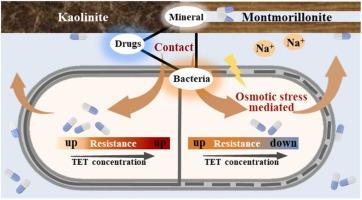控制四环素对粘土矿物抗性的界面过程
IF 11.3
1区 环境科学与生态学
Q1 ENGINEERING, ENVIRONMENTAL
引用次数: 0
摘要
土壤矿物质是抗生素和微生物活动的热点,对抗生素耐药性(AR)的发展构成潜在风险。了解矿物界面过程调节AR的机制对于制定有效的AR缓解策略至关重要。本研究考察了两种具有代表性的粘土矿物蒙脱土和高岭石在四环素(TET)诱导AR中的作用。结果表明,在实验浓度范围(0.1 ~ 2.0 mg/L TET)内,高岭石显著增强了细菌的耐药性,提高了15.63 ~ 56.06倍。相比之下,蒙脱土在较低TET浓度(0.1 ~ 1.0 mg/L)下增加抗性,而在较高浓度(>1.0 mg/L)下降低抗性,表现出双浓度依赖效应。细菌-矿物异质聚集放大TET暴露和生物利用度。当浓度为1.0 mg/L时,蒙脱土通过层间吸附使TET的生物利用度降低5.17%,而高岭土使TET的生物利用度提高了7.82% ~ 27.84%,促进了细胞内TET的残留。蒙脱土释放的钠离子介导了细菌的渗透胁迫,激活了离子转运体,导致细胞内TET残留降低。这种矿物特异性应激反应与生物利用度驱动的进化协同作用,重塑抗性发展。这些发现突出了黏土矿物界面在AR发展中的关键作用,为预测和控制土壤环境中的AR提供了理论支持。本文章由计算机程序翻译,如有差异,请以英文原文为准。

Interfacial processes governing tetracycline-induced resistance on clay minerals
Soil minerals act as hotspots for antibiotics and microbial activity, posing potential risks for antibiotic resistance (AR) development. Understanding the mechanisms by which mineral interfacial processes regulate AR is critical for developing effective AR mitigation strategies. This study investigated the roles of two representative clay minerals, i.e. montmorillonite and kaolinite, in tetracycline (TET) induced AR. Results showed that kaolinite significantly enhanced bacterial resistance by 15.63–56.06-fold within the experimental concentration range (0.1–2.0 mg/L TET). In contrast, montmorillonite increased resistance at lower TET concentrations (0.1–1.0 mg/L) while decreasing it at higher concentrations (>1.0 mg/L), exhibiting dual concentration-dependence effects. Bacterial-mineral heteroaggregation amplifies TET exposure and bioavailability. Kaolinite increased TET bioavailability by 7.82%–27.84% and promoted intracellular TET residue, whereas montmorillonite reduced TET bioavailability by 5.17% at 1.0 mg/L through interlayer TET adsorption. The sodium ions released by montmorillonite mediated osmotic stress in bacteria, activating ion transporters and leading to lower intracellular TET residue. This mineral-specific stress response synergizes with bioavailability-driven evolution to reshape resistance development. These findings highlight the crucial role of clay mineral interfaces in the development of AR, offering theoretical support for predicting and controlling AR in soil environments.
求助全文
通过发布文献求助,成功后即可免费获取论文全文。
去求助
来源期刊

Journal of Hazardous Materials
工程技术-工程:环境
CiteScore
25.40
自引率
5.90%
发文量
3059
审稿时长
58 days
期刊介绍:
The Journal of Hazardous Materials serves as a global platform for promoting cutting-edge research in the field of Environmental Science and Engineering. Our publication features a wide range of articles, including full-length research papers, review articles, and perspectives, with the aim of enhancing our understanding of the dangers and risks associated with various materials concerning public health and the environment. It is important to note that the term "environmental contaminants" refers specifically to substances that pose hazardous effects through contamination, while excluding those that do not have such impacts on the environment or human health. Moreover, we emphasize the distinction between wastes and hazardous materials in order to provide further clarity on the scope of the journal. We have a keen interest in exploring specific compounds and microbial agents that have adverse effects on the environment.
 求助内容:
求助内容: 应助结果提醒方式:
应助结果提醒方式:


